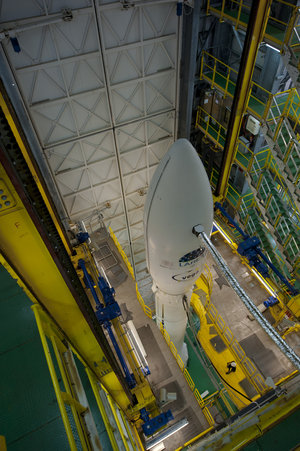CubeSats on Vega's first launch
The ESA CubeSat programme began in 2007 when the Agency decided to include an educational payload on the inaugural flight of the Vega launch vehicle.
The announcement of opportunity issued by ESA’s Education Office in February 2008 offered the possibility of launching up to nine university CubeSats free-of-charge on Europe’s newest launcher.
CubeSats are picosatellites of standardised dimensions (cubes of 10 cm per side, with a maximum mass of 1 kg) which can be operated from university or radio amateur ground stations. They are used as an educational tool that offers hands-on experience to aerospace engineering students in designing, developing, testing and operating a spacecraft system and its ground segment.
The seven Cubesats launched on Vega’s inaugural flight were developed by more than 250 university students from six different countries over the last four years.
Each CubeSat carries its own scientific or technology demonstration payload:
- Xatcobeo (a collaboration of the University of Vigo and INTA, Spain): a mission to demonstrate software-defined radio and solar panel deployment;
- Robusta (University of Montpellier 2, France): a mission to test and evaluate radiation effects (low dose rate) on bipolar transistor electronic components;
- e-st@r (Politecnico di Torino, Italy): demonstration of an active 3-axis attitude determination and control system including an inertial measurement unit;
- Goliat (University of Bucharest, Romania): imaging of Earth using a digital camera and in-situ measurement of radiation dose and micrometeoroid flux;
- PW-Sat (Warsaw University of Technology, Poland): a mission to test a deployable atmospheric drag augmentation device for de-orbiting CubeSats;
- MaSat-1 (Budapest University of Technology and Economics): a mission to demonstrate various spacecraft avionics, including a power conditioning system, transceiver and onboard data handling;
- UniCubeSat GG (University of Rome La Sapienza, Italy):a mission to study the gravity gradient.

The CubeSats were deployed from their different deployment systems mounted on the support structure of the main payload, LARES, into an orbit of 300 x 1450 km at an inclination of 69.5 degrees. They have a natural orbital lifetime of up to four years, depending on their rate of orbital decay due to atmospheric drag.
CubeSats are pico-satellites of standardised dimensions (cubes of 10 cm per side, with a maximum mass of 1 kg) which can be operated from university or radio amateur ground stations. They are used as an educational tool that offers hands-on experience to aerospace engineering students in designing, developing, testing and operating a spacecraft system and its ground segment.
The P-POD systems are supplied to ESA by CalPoly (California Polytechnic State University, San Luis Obispo, USA, which is also supporting ESA in the integration and test campaign at ESA's technical heart ESTEC in The Netherlands, as well as the launch campaign at Europe's Spaceport in French Guiana.













